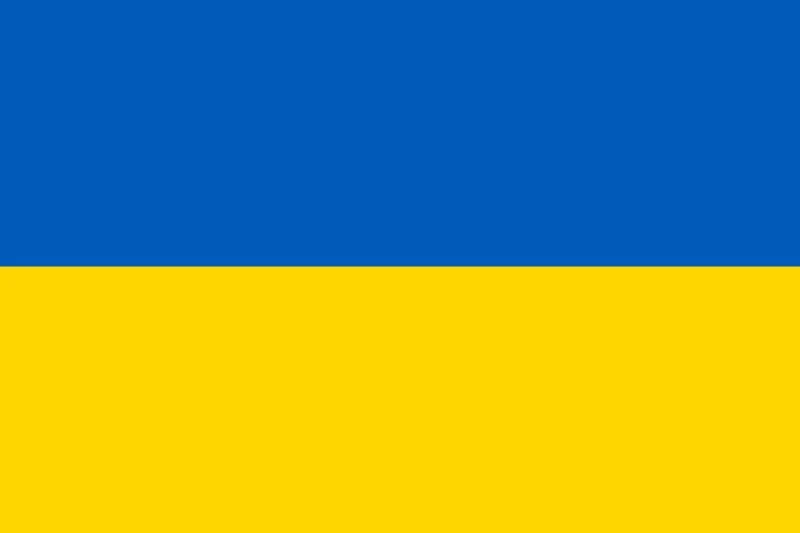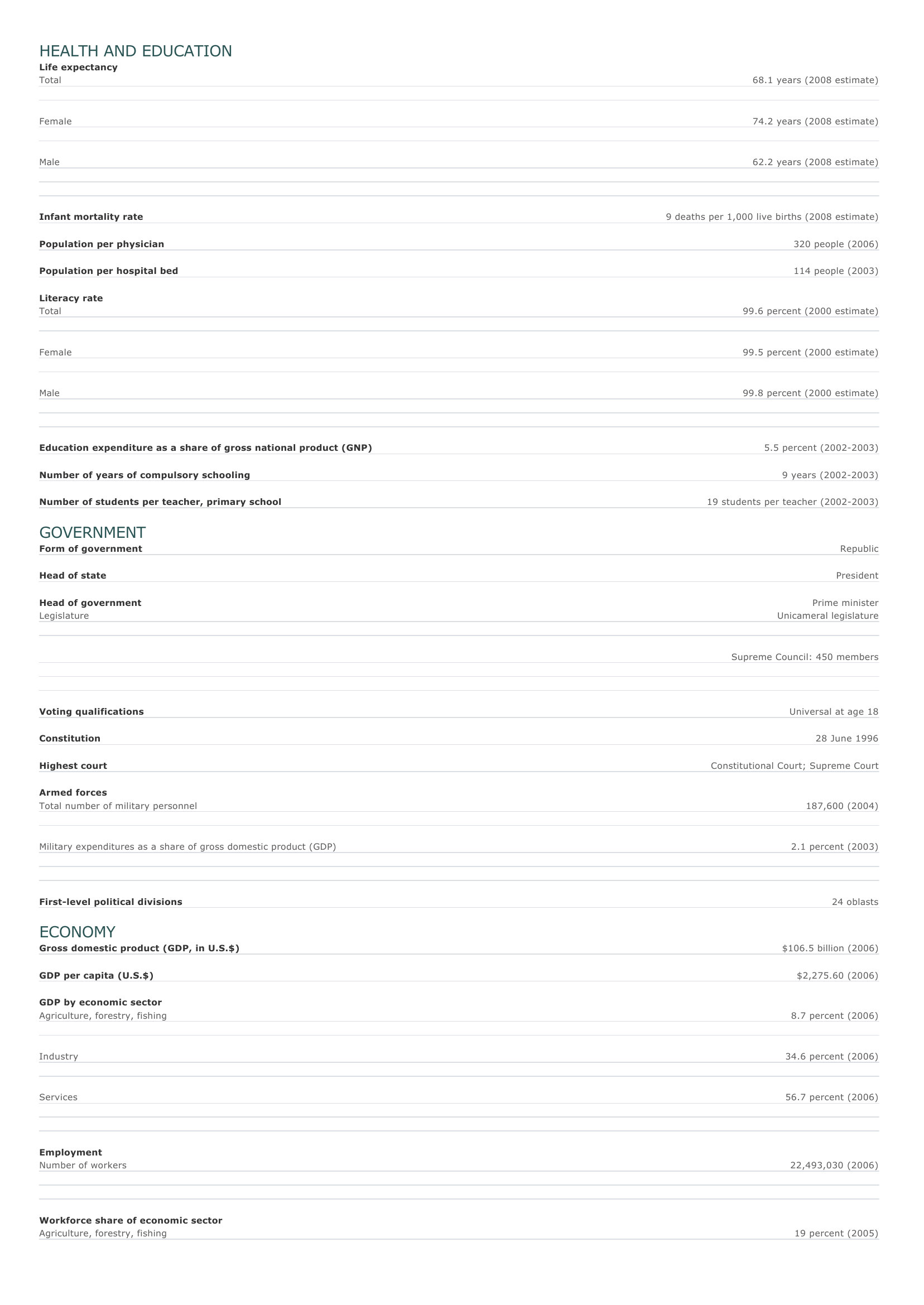
Ukraine Facts and Figures. BASIC FACTS Official name Capital Area Ukraine Kyiv 603,700 sq km 233,100 sq mi PEOPLE Population 45,994,287 (2008 estimate) Population growth Population growth rate -0.65 percent (2008 estimate) Projected population in 2025 41,037,583 (2025 estimate) Projected population in 2050 33,573,842 (2050 estimate) Population density 76 persons per sq km (2008 estimate) 197 persons per sq mi (2008 estimate) Urban/rural distribution Share urban 67 percent (2005 estimate) Share rural 33 percent (2005 estimate) Largest cities, with population Kyiv 2,618,000 (2003 estimate) K harkiv 1,445,173 (2005 estimate) Dnipropetrovs'k 1,040,000 (2007 estimate) Odessa 989,468 (2005 estimate) Donets'k 991,310 (2005 estimate) Ethnic groups Ukrainian 73 percent Russian 22 percent O ther 5 percent Languages Ukrainian (official), Russian, Romanian, Polish Religious affiliations Orthodox (Ukrainian) Christian 54 percent Eastern Catholic (Byzantine rite) 11 percent Atheist 4 percent Nonreligious 10 percent O ther 20 percent HEALTH AND EDUCATION Life expectancy Total 68.1 years (2008 estimate) Female 74.2 years (2008 estimate) Male 62.2 years (2008 estimate) Infant mortality rate 9 deaths per 1,000 live births (2008 estimate) Population per physician 320 people (2006) Population per hospital bed 114 people (2003) Literacy rate Total 99.6 percent (2000 estimate) Female 99.5 percent (2000 estimate) Male 99.8 percent (2000 estimate) Education expenditure as a share of gross national product (GNP) Number of years of compulsory schooling Number of students per teacher, primary school 5.5 percent (2002-2003) 9 years (2002-2003) 19 students per teacher (2002-2003) GOVERNMENT Form of government Head of state Head of government Legislature Republic President Prime minister Unicameral legislature Supreme Council: 450 members Voting qualifications Constitution Highest court Armed forces Total number of military personnel Military expenditures as a share of gross domestic product (GDP) First-level political divisions Universal at age 18 28 June 1996 Constitutional Court; Supreme Court 187,600 (2004) 2.1 percent (2003) 24 oblasts ECONOMY Gross domestic product (GDP, in U.S.$) GDP per capita (U.S.$) GDP by economic sector Agriculture, forestry, fishing $106.5 billion (2006) $2,275.60 (2006) 8.7 percent (2006) I ndustry 34.6 percent (2006) Services 56.7 percent (2006) Employment Number of workers Workforce share of economic sector Agriculture, forestry, fishing 22,493,030 (2006) 19 percent (2005) I ndustry 24 percent (2005) Services 56 percent (2005) Unemployment rate 8.6 percent (2004) National budget (U.S.$) Total revenue 39,012 million (2006) Total expenditure 39,647 million (2006) Monetary unit 1 hryvnia, consisting of 100 kopiykas Major trade partners for exports Russia, Turkey, Italy, Germany, and United States Major trade partners for imports Russia, Turkmenistan, Germany, Kazakhstan, and United States ENERGY, COMMUNICATIONS, AND TRANSPORTATION Electricity production Electricity from thermal sources Electricity from hydroelectric sources Electricity from nuclear sources Electricity from geothermal, solar, and wind sources 48.79 percent (2003 estimate) 6.06 percent (2003 estimate) 45.14 percent (2003 estimate) 0.01 percent (2003 estimate) Number of radios per 1,000 people 882 (1997) Number of telephones per 1,000 people 256 (2004) Number of televisions per 1,000 people 465 (2000 estimate) Number of Internet hosts per 10,000 people 18 (2003) Daily newspaper circulation per 1,000 people 175 (2000) Number of motor vehicles per 1,000 people 138 (2004) Paved road as a share of total roads 97 percent (2004) SOURCES Basic Facts and People sections Area data are from the statistical bureaus of individual countries. Population, population growth rate, and population projections are from the United States Census Bureau, International Programs Center, International Data Base (IDB) (www.census.gov). Urban and rural population data are from the Food and Agriculture Organization (FAO) of the United Nations (UN), FAOSTAT database (www.fao.org). Largest cities population data and political divisions data are from the statistical bureaus of individual countries. Ethnic divisions and religion data are largely from the latest Central Intelligence Agency (CIA) World Factbook and from various country censuses and reports. Language data are largely from the Ethnologue, Languages of the World, Summer Institute of Linguistics International (www.sil.org). Health and Education section Life expectancy and infant mortality data are from the United States Census Bureau, International Programs Center, International database (IDB) (www.census.gov). Population per physician and population per hospital bed data are from the World Health Organization (WHO) (www.who.int). Education data are from the United Nations Educational, Scientific and Cultural Organization (UNESCO) database (www.unesco.org). Government section Government, independence, legislature, constitution, highest court, and voting qualifications data are largely from various government Web sites, the latest Europa World Yearbook, and the latest Central Intelligence Agency (CIA) World Factbook. The armed forces data is from Military Balance. Economy section Gross domestic product (GDP), GDP per capita, GDP by economic sectors, employment, and national budget data are from the World Bank database (www.worldbank.org). Monetary unit, agriculture, mining, manufacturing, exports, imports, and major trade partner information is from the statistical bureaus of individual countries, latest Europa World Yearbook, and various United Nations and International Monetary Fund (IMF) publications. Energy, Communication, and Transportation section Electricity information is from the Energy Information Administration (EIA) database (www.eia.doe.gov). Radio, telephone, television, and newspaper information is from the United Nations Educational, Scientific and Cultural Organization (UNESCO) database (www.unesco.org). Internet hosts, motor vehicles, and road data are from the World Bank database (www.worldbank.org). Note Figures may not total 100 percent due to rounding. Microsoft ® Encarta ® 2009. © 1993-2008 Microsoft Corporation. All rights reserved.




































